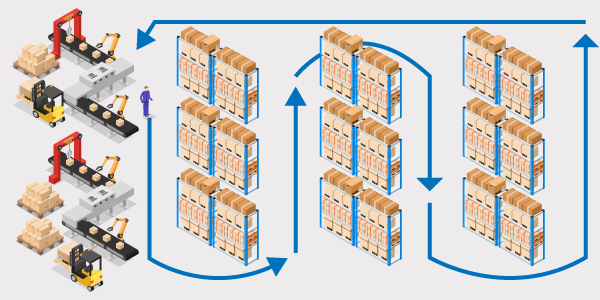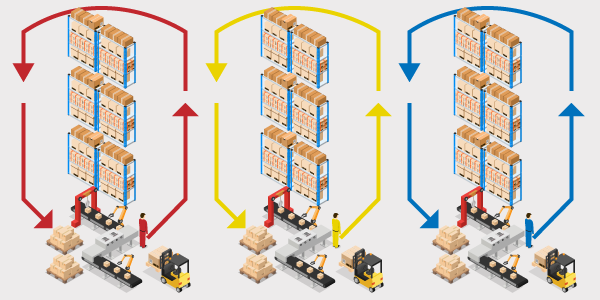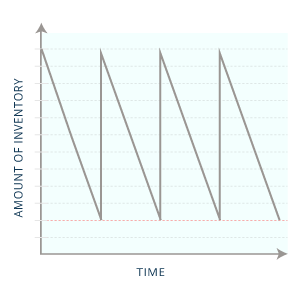The warehouse is where inventory lives. It finds a comfortable spot during receiving, stays put until a customer purchases it, and then finds its way to the customer through the fulfillment process.
Yes, that’s an oversimplification. But managing each of these steps requires careful coordination - particularly in large warehouses with many employees.
As your business grows and you add larger warehouses or more team members, the complexity required to manage warehouse operations smoothly will increase. The consequences of not having a smooth process can grow proportionally as well - you don’t want too many cooks in the kitchen.
Safety First
Always prioritizing warehouse safety is a foolproof approach. Safe employees are:
- Happier
- More productive
- Less expensive
While focusing on reducing injuries and accidents may seem like a good approach, a more effective (and proactive) method would be building in training up front for new employees and recurring training for all employees. This creates a culture of safety, and ensures that equipment isn’t damaged, employees are healthy, and products get to customers quickly and without issue.
Safe employees are happier, and by prioritizing safety, managers show through their actions that their wellbeing is a top priority.
And yes, there are financial benefits to safety as well. Workers compensation is a largely preventable expensive, and scheduling other workers to cover lost time or paying overtime to a stretched staff can have negative effects on morale and profits.
Be proactive and prioritize safety. It’s worth it.
Care for Equipment
When I was young, my parents would always tell me to take good care of my things. Toys, technology, shoes - all of it. I was never very good at understanding the value of objects until I started to pay for them myself.
In a warehouse, where equipment can cost thousands or tens of thousands of dollars, a certain amount of caution has to be in place to protect that investment over the years it will be in use.
The same goes for shelving, tables, stands, and the other menagerie of equipment present in a fully functional warehouse. Accidents are unavoidable, but with good training and proper care, equipment can last a lifetime. A variety of training, maintenance, and caution are all necessary.
Without proper care, equipment can break down or deteriorate faster, causing premature costs of thousands or tens of thousands of dollars, depending on the equipment. It can also lead to damaged products, causing irreparable damage to a large amount of product in transit or in storage.
Lastly, the time savings are important - installing or purchasing new equipment can slow down day to day operations, and move focus away from getting *** done.
Flow
Creating a sense of flow in a warehouse can have an uplifting effect on efficiency.
You’ve no doubt heard the comparison of shopping in a grocery store - dashing up and down the aisles, forgetting something and having to backtrack, and not knowing where you’re headed. If a warehouse is organized like that, there’s no chance it’ll be a quick process for picking.
A good flow also reduces the chance of accidents or blockages in high traffic areas. Civil engineers plan roads and intersections so that vehicles can move efficiently and safely - you’ve got your work cut out for you, since a warehouse is much smaller than a city or town. Regardless, the benefits are the same: increased safety and speed with lower congestion.
Picking
Travel time can easily account for 50% or more of order picking hours. That’s why your goal should be to reduce the time spent picking, by reducing the amount of distance needed to be traveled.
Lay out your warehouse so that pickers take a single path through it - the same path every time - that covers all items that may be needed. A single path allows faster transit time, shorter distance, and lower chance of accidents, since all employees are moving sequentially.

Another option is assigning batch or zone picking. For example, a certain group of employees may be assigned to pick certain items, or a certain area in the warehouse.

With separate groups of employees doing this, they won’t interfere with each other when picking.
Packing
Clearly setting up packing stations with equipment and supplies within easy reach is a no brainer. Automating shipping carrier and service level decisions and pre-printing shipping labels is next level efficiency.
But there’s a lot to improving packing efficiency.
Keeping a clean and organized packing area, with easy access to equipment and supplies is essential. With additional clutter comes confusion and slower packing times.
Organization
An organized warehouse is the natural byproduct of following the above recommendations of safety, care, and flow.
In a perfect world, aisles are clean and have plenty of space to move around for the most popular products. Completing an ABC analysis locates the C products in the most convenient spot - easily trafficked, lots of space for multiple routes and easy put away, and if an accident does happen, the consequences are lower because they are surrounded by other C products.
This separates the A products to low traffic areas of the warehouse, rightly giving these high value items preferential treatment and fewer touch points.
Regardless of which category products fall into, aisles, shelves, bins, and any other sections are clearly labeled. Having items at about shoulder height, with SKU and product names readily available can speed up the picking process tremendously.
Everything should have a place - wheeled equipment, packing stations, and receiving areas are in the optimal placement for the lowest amount of transit time and steps to complete given tasks.
Iteration
Possibly the most important step to managing warehouse operations is continuous improvement. After all, the output of measuring key performance indicators is an improvement to the process. And when a change is made, KPIs are checked again and then more improvements are made.
Start With Measurement
There’s a Peter Drucker quote in here for good reason. Without measuring, you can’t manage. The first step to iterating is to measure inventory KPIs important to the business.
Get Good Feedback
Good feedback comes from every angle of the business: front-line workers that see their area, managers that see a full department or function, and executives that see the whole business. If feedback and changes are pushed from the top down with no input from other stakeholders, the changes aren’t likely to stick.
This is particularly true when coming up with great ideas for changes. Front line employees might see things and be exposed to situations that management doesn’t fully understand, simply because they don’t do it on a day to day basis.
Soliciting feedback from all sides is the best way to make an effective change.
Make a Change and Measure its Effectiveness
Once a change is made, be sure to train all relevant employees on how to approach it, and set a date to measure its effectiveness. The first day a new process is in place isn’t the best time to measure it, so it’s probably more effective to do this monthly or quarterly.
Solve for the Customer First
The purpose of doing all this and improving warehouse operations is to create a better experience for the customer. Don’t forget that!
Customer Stories
Blog
Guides & Ebooks












